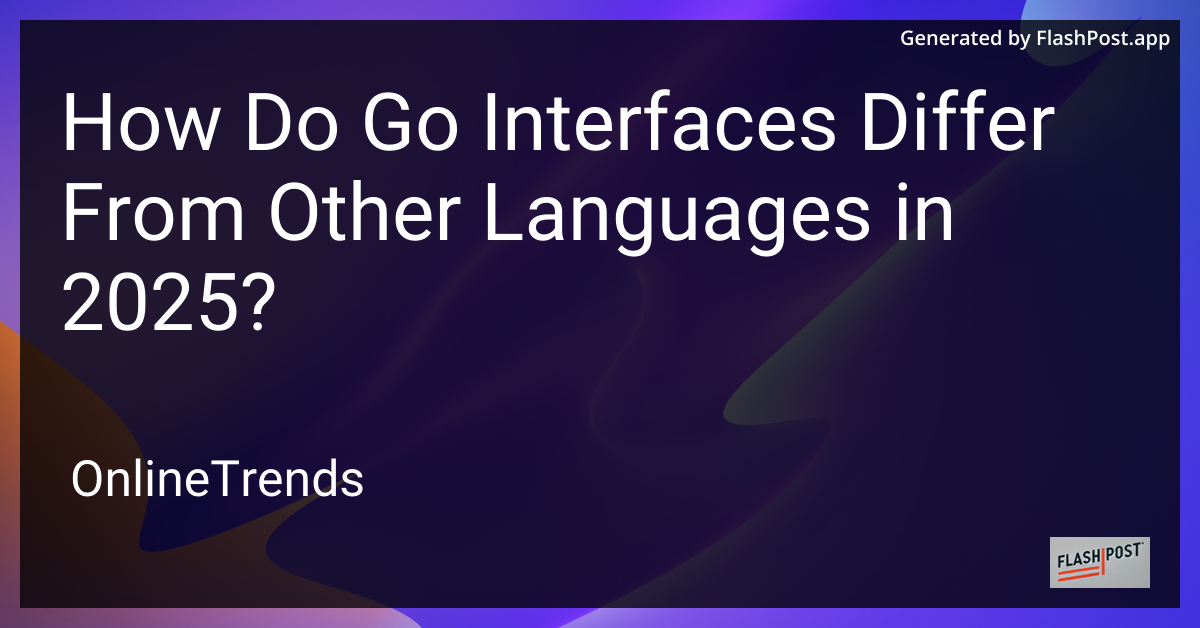
Best Golang Books to Buy in 2025
| Product | Features | Price |
|---|---|---|
 System Programming Essentials with Go: System calls, networking, efficiency, and security practices with practical projects in Golang |
Shop now 🛍️  |
|
 Event-Driven Architecture in Golang: Building complex systems with asynchronicity and eventual consistency |
Shop now 🛍️  |
|
 Microservices with Go: The expert's guide to building secure, scalable, and reliable microservices with Go |
Shop now 🛍️  |
|
 Kubernetes in Action |
Shop now 🛍️  |
|
 Pro Go: The Complete Guide to Programming Reliable and Efficient Software Using Golang |
Shop now 🛍️  |
In the evolving landscape of programming languages, Go (or Golang) has continued to stand out with its unique approach to interfaces. As of 2025, Go interfaces remain an integral part of programming, offering both flexibility and efficiency. Understanding how Go interfaces differ from those in other languages is crucial for developers aiming to leverage the power of Go in their projects.
Understanding Go Interfaces
In Go, interfaces provide a way to specify behavior that a type must implement. An interface is a type that specifies one or more method signatures. When a type provides definitions for all the methods in the interface, it is said to 'implement' the interface. This occurs implicitly in Go, meaning there's no need for explicit declaration of intent, unlike in languages such as Java or C#.
Implicit Satisfaction
One of the most significant differences in Go's approach is the implicit satisfaction of interfaces. In many other languages, developers must explicitly declare that a class or struct implements an interface. Go simplifies this by automatically recognizing when a type satisfies an interface, reducing boilerplate and improving readability.
Decoupling and Flexibility
Another standout feature of Go interfaces is their role in decoupling code. Interfaces in Go are lightweight and designed to define minimal sets of methods. This focus on minimalism promotes flexibility and makes mocking for testing straightforward, which is an advantage over more verbose interfaces in other languages.
How Go Interfaces Differ from Java and C
Explicit vs. Implicit
Both Java and C# require explicit implementation declarations. In contrast, Go's implicit implementation reduces code clutter and enhances the flexibility of composing new behaviors from existing ones without being tightly coupled to specific implementations.
Use Cases and Simplicity
In Java and C#, interfaces often carry additional burdens such as default method implementations or nested types. Go, however, maintains its philosophy of simplicity with interfaces strictly focused on method contracts. This simplicity ensures that Go interfaces remain both powerful and easy to use.
Comparison with Python
Duck Typing vs. Go's Interfaces
While Python utilizes duck typing, allowing any object with the required methods to be passed to a function, Go relies on defined interfaces for type checking. This ensures that concerns about method existence and structure are addressed at compile time rather than at runtime, enhancing reliability and reducing runtime errors.
Practical Applications
The use of Go interfaces is prevalent in leading edge domains such as cloud computing, microservices, and concurrent programming. These applications are further enriched by advanced reflection techniques in Golang and concurrent pattern implementations, such as the Golang CMF implementation.
Conclusion
The distinctions between Go interfaces and those of other languages like Java, C#, and Python highlight Go's unique place in the modern programming landscape as of 2025. For developers, understanding these differences is crucial to harnessing the full potential of Go, particularly in writing clean, efficient, and maintainable code.
To explore more about utilizing interfaces efficiently, you can learn how to use the interface as a parameter in Golang, further expanding your understanding and application of Go interfaces.
By embracing the power of Go interfaces, developers can build robust and scalable applications that take full advantage of Go's simplicity and performance.